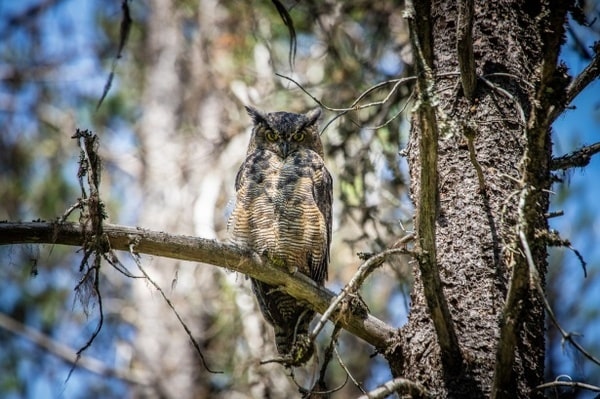After spending the night hunting, owls will rest at their roost. To roost at night, Owls require mature, dense trees with strong trunks. If they are large enough, both deciduous and coniferous trees will work well. Most owls prefer to roost alone.
A few species roost together or share a roosting space with others of the same species. Although the exact benefits of sharing a roost with other owls are not known, they may be beneficial in some way.
- The owls may take turns looking for predators.
- They may also snuggle together to keep warm.
- Shared roosts may make it easier for owls in the breeding season to find their mates.
- They might even share information about great hunting spots.
Most owl species are nocturnal. This means that they are awake during the day and hunt at night. This is not true for all owl species, however, some eat their prey during daylight hours.
Types of Owls based on their sleeping habits :
- Nocturnal Owl – These owls are active at night. These owls are very active at night to hunt and mate or avoid heat and predators.
- Diurnal Owls – These Owls are active during daylight hours but sleep at night. Some people find it difficult to see an owl in the daytime. The northern pygmy is often seen at night. Two owl species that are truly diurnal include the northern-hawk owl, and the northern pygmy.
- Crepuscular owls – These owls do their most active activities at dusk and dawn. They hunt day and night. Barn Owls, like other owls, are crepuscular. They hunt at dawn and dusk, flying low above rough grassland, hedges, and ditches in search of voles, shrews, and mice.


Is It Possible To See An Owl In The Day ?
- Owls can hide very well during the day. Even if they are directly in front of you, they may try to hide behind objects and be difficult to see. The clues are what make daytime owling possible. The accumulation of pellets directly below the roost site is one clue as to where an owl is hiding.
- The larger the owl’s talons and prey, the more it will take and the bigger the pellet. Two pellets are usually consumed by owls every day. One at nighttime feeding sites and one at the daytime roost. One can calculate how long an owl has lived in a particular area by counting the pellets that are under its roost.
- The white-wash is a thick, chalky, white excreta that owls produce. This is a clue to day-time owlers. Whitewash from an owl eventually builds up, and it drips down through the branches below its perch. Whitewash can be seen from afar, so make sure you have binoculars to inspect the tree before going closer. If you are lucky, the owl may be still present in the branches, hidden from view.
- You can also see owls at dusk and dawn. Great Horned Owls fly to their favorite snag at dusk to start their day. Use binoculars and a scope to look for unusual snags or perches.
Related Post
- Do Owls Eat Birds : Let’s Understand Why
- Do Owls Blink – Lets Understand The Science Behind It
- Do Owls Attack Humans : Let’s Understand It Why
- Do Hawks Eat Owls – Explanation
- Do Owls Eat Chickens – Explanation
Resources
